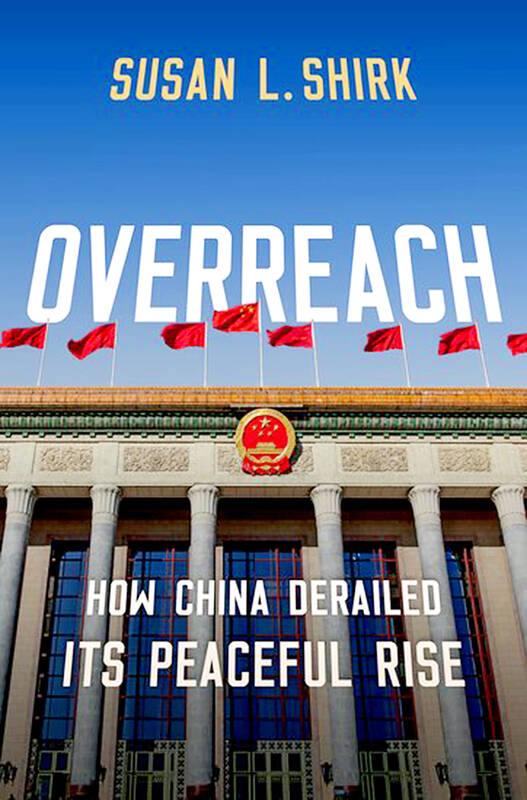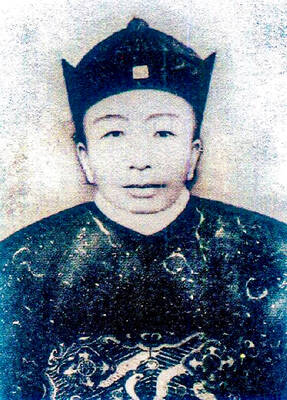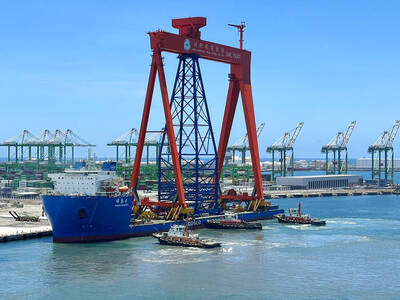Since Xi Jinping (習近平) assumed power, relations between China and the US have deteriorated to the point where many analysts fear confrontation could be inevitable. A contemporary Cold War has made the lines of communication between the two powers increasingly choppy, and Xi’s personalistic, autocratic leadership style has made Beijing’s policymaking unpredictable. How did things come to this pass, and how can they be brought back from the brink?
Drawing on a half-century of experience as a China scholar and three years as deputy assistant secretary of state in the Bureau of East Asia and Pacific Affairs under former US President Bill Clinton, Susan L. Shirk attempts to answer these questions in this timely, valuable book. As Shirk traces the evolution of China’s overreach, which she defines as “going to excess in a way that is costly to oneself,” it is quickly apparent that her thesis is an original and perhaps counterintuitive one. Rather than seeing the origins of China’s overreach and the concomitant breakdown of Sino-US relations in the “disruptive” leadership of Xi and former US President Donald Trump, Shirk believes that there were clear signs of a tendency in this direction a decade earlier.
This, she admits, is somewhat paradoxical, given the “colorless, mild mannered” leadership of Xi’s predecessor, Hu Jintao (胡錦濤). China has oscillated between two “patterns of rule” since Mao Zedong (毛澤東) — idiosyncratic dictatorship and collective leadership; to understand why both resulted in overreach, Shirk delves into “the ‘black box’ of high-level Chinese politics.”

The dynamic at play, she asserts, is different in each case.
“Theoretically,” she writes, “when officials make decisions by consensus in a collective leadership, their ability to check one should produce restraint, or even inertia, not overreach.”
Instead, the vacuum at the top allowed bigwigs from the Chinese Communist Party’s Politburo and its standing committee to compete for budgets and power for the various departments and interest groups they represented. They do so by “exaggerating foreign and domestic threats confronting the country.”
The system also naturally lent itself to back-scratching with the various groups carte blanche approving one another’s programs based on strategic alliances. Finally, corruption was rife under Hu.
“High-ranking politicians and military officers rake in huge amounts of money under the system of dispersed power.”
Little wonder then that the Chinese public “welcomed Xi’s determination to end the dishonest dealings …”
ON THE BANDWAGON
Moving to centralize power, Xi has drawn on “the fables about domestic and foreign threats” from the Hu era. Surrounded by sycophants who “bandwagon” to his line, Xi “believes his own myths.” With no one questioning him or relaying bad news, he has extended China’s overreach far further than ever.
As one of Xi’s “core concerns,” Taiwan is inevitably a focus, particularly in the book’s conclusion, where Shirk even-handedly presents policy suggestions to temper Chinese overreach and American overreaction to it. Asserting that “many Chinese are convinced that Xi sought a third term because that’s when he intends to reunify the island,” she nonetheless emphasizes that few Taiwanese see moves in this direction as “imminent or inevitable.” Leading American analysts are generally of the same view.
Nonetheless, “Congress and the policy community” have ramped up the rhetoric on the threat and become more vocal than ever in their support of Taiwan. Although publication of this book obviously occurred before then US House Speaker Nancy Pelosi’s visit to Taiwan and China’s subsequent missile lobbing hissy-fit, Shirk highlights an uptick in encroachments over the Taiwan Strait’s median line by People’s Liberation Army air force fighter jets. This, she notes, often accompanied visits to Taiwan by American officials or developments related to relations to relations between Taipei and Washington.
INTIMIDATION TACTICS
Now that Xi appears to have given up hope of winning Taiwanese “hearts and minds (and pocketbooks),” which had appeared to be the strategy under the Chinese Nationalist Party (KMT) regime of former president Ma Ying-jeou (馬英九), he has had to resort to intimidation, “especially now that the new Hong Kong Security Law has destroyed the credibility of the ‘one country, two systems pledge’ to continue Taiwan’s autonomy.”
Some foreign policy experts such as Richard Haass — the president of the Council of Foreign Relations — are calling for a reversal of the “strategic ambiguity” approach that has informed Washington’s attitude toward tensions in the Taiwan Strait for so long. Shirk disagrees with this. A new policy of “strategic clarity,” she argues, would actually make relations with both China and Taiwan trickier. It would confirm China’s suspicion that the goal of US policy is to permanently detach Taiwan from the mainland and use it as a base for the US [sic] containment of China.”
With this in mind, Shirk believes that the best option is for Washington to “stay steady on Taiwan” by helping Taipei “weave a denser network of informal ties with other countries,” which would not only ensure “Xi would pay a higher price for any attack on the island,” but might also create opportunities for Taiwan’s participation in multilateral trade agreements and international organizations. Thanks to Xi’s overreach, Japan, India, and Australia — who with the US form the so-called Quad alliance — would be onboard, as would much of Europe and Southeast Asia, where many countries feel increasingly threatened by Chinese belligerence in the South China Seas.
LEAP OF FAITH
Shirk also advises Xi to initiate direct dialogue with Taipei “without preconditions,” reasoning that he would “discover that he has more domestic latitude” on cross-strait relations that he realizes — at least with the public.
These and other sensible policy suggestions round out the book. Most of them are on point, but they invariably hinge on the assumption that Xi can be influenced to “exercise greater self-restraint” and step back from his “arbitrary and imprudent decisions” and “rash risk-taking.” Recommendations such as the call for Xi to close the Re-education camps in Xinjiang to avoid tarnishing his legacy seem so almost miss the point: These are policies that he has personally crafted and that he continues to back to the hilt. There is absolutely no indication that he would even consider toning them down.
Shirk’s depiction of Xi’s paranoid strongman type of rule, where — as foreseen by his predecessor Deng Xiaoping (鄧小平) — an overconcentration of power has created an echo-chamber that leaves him “unfettered domestically,” make hopes of influencing him a chasmic leap of faith. She admits to being “agnostic” about the prospects of diplomacy with Xi’s China, but rightly concludes that “we must test the proposition.” To do otherwise would be to continue down the road to potential catastrophe.

The canonical shot of an East Asian city is a night skyline studded with towering apartment and office buildings, bright with neon and plastic signage, a landscape of energy and modernity. Another classic image is the same city seen from above, in which identical apartment towers march across the city, spilling out over nearby geography, like stylized soldiers colonizing new territory in a board game. Densely populated dynamic conurbations of money, technological innovation and convenience, it is hard to see the cities of East Asia as what they truly are: necropolises. Why is this? The East Asian development model, with

June 16 to June 22 The following flyer appeared on the streets of Hsinchu on June 12, 1895: “Taipei has already fallen to the Japanese barbarians, who have brought great misery to our land and people. We heard that the Japanese occupiers will tax our gardens, our houses, our bodies, and even our chickens, dogs, cows and pigs. They wear their hair wild, carve their teeth, tattoo their foreheads, wear strange clothes and speak a strange language. How can we be ruled by such people?” Posted by civilian militia leader Wu Tang-hsing (吳湯興), it was a call to arms to retake

This is a deeply unsettling period in Taiwan. Uncertainties are everywhere while everyone waits for a small army of other shoes to drop on nearly every front. During challenging times, interesting political changes can happen, yet all three major political parties are beset with scandals, strife and self-inflicted wounds. As the ruling party, the Democratic Progressive Party (DPP) is held accountable for not only the challenges to the party, but also the nation. Taiwan is geopolitically and economically under threat. Domestically, the administration is under siege by the opposition-controlled legislature and growing discontent with what opponents characterize as arrogant, autocratic

When Lisa, 20, laces into her ultra-high heels for her shift at a strip club in Ukraine’s Kharkiv, she knows that aside from dancing, she will have to comfort traumatized soldiers. Since Russia’s 2022 invasion, exhausted troops are the main clientele of the Flash Dancers club in the center of the northeastern city, just 20 kilometers from Russian forces. For some customers, it provides an “escape” from the war, said Valerya Zavatska — a 25-year-old law graduate who runs the club with her mother, an ex-dancer. But many are not there just for the show. They “want to talk about what hurts,” she